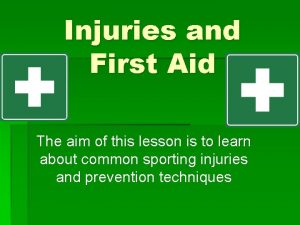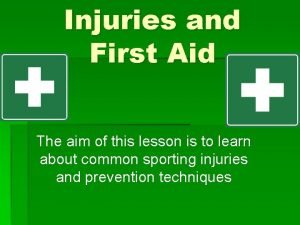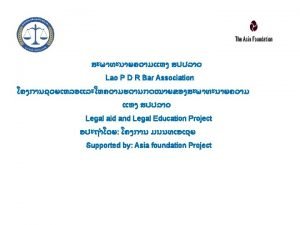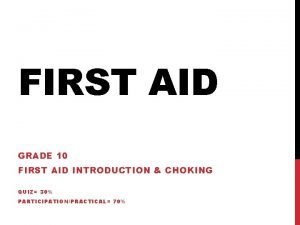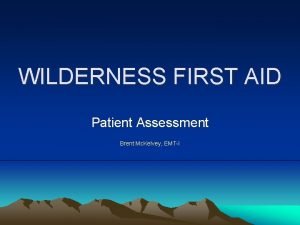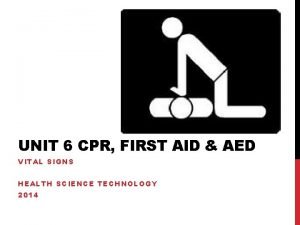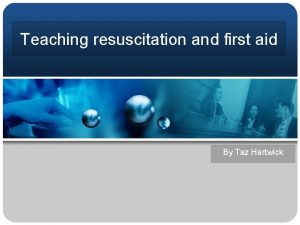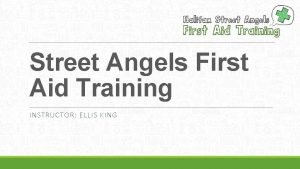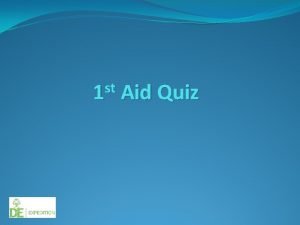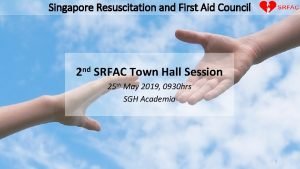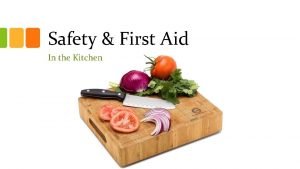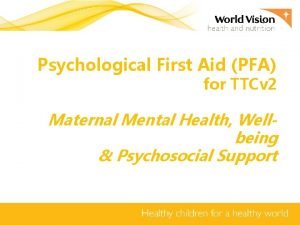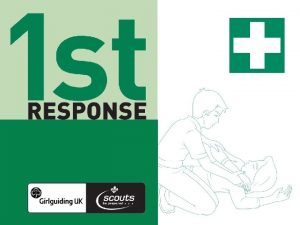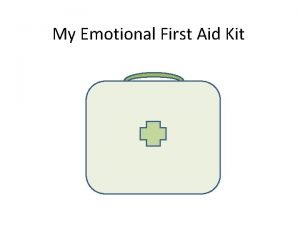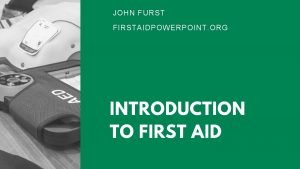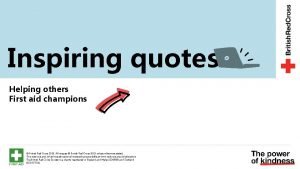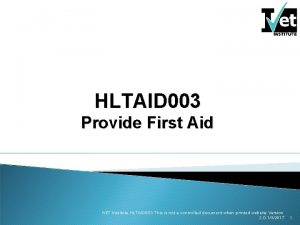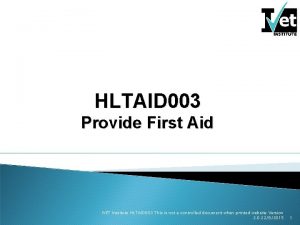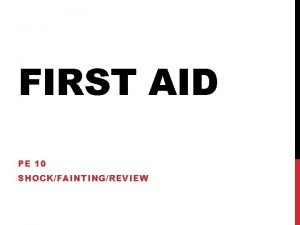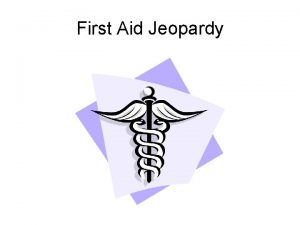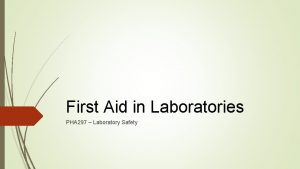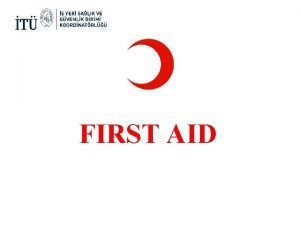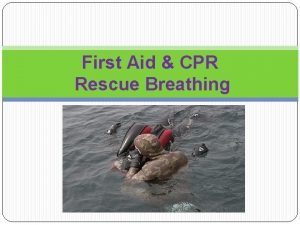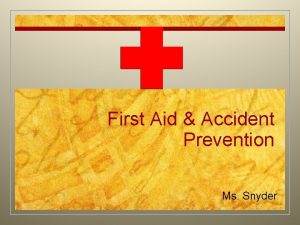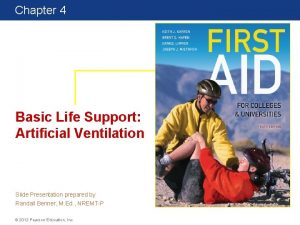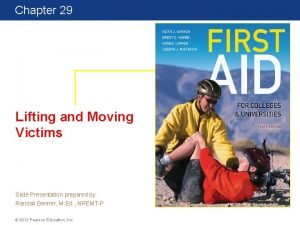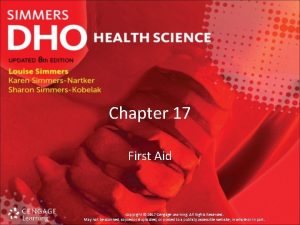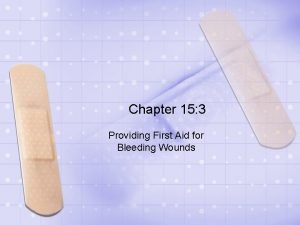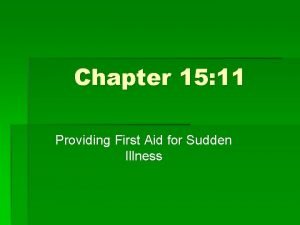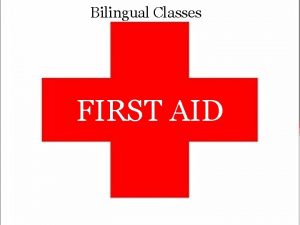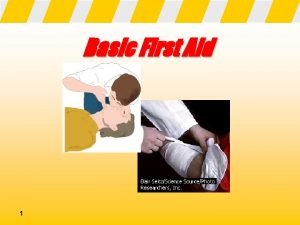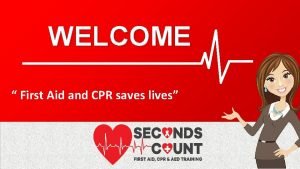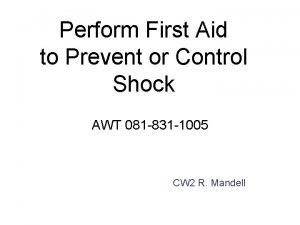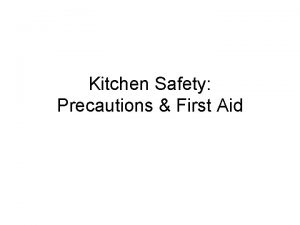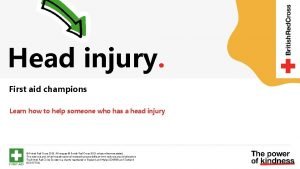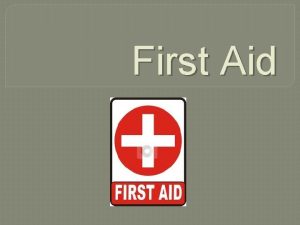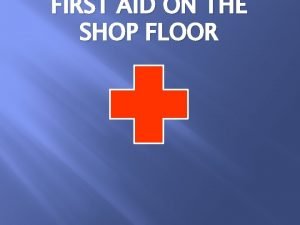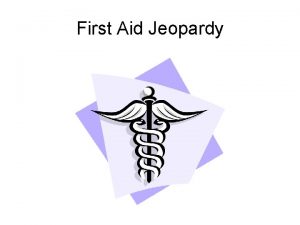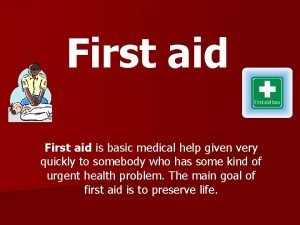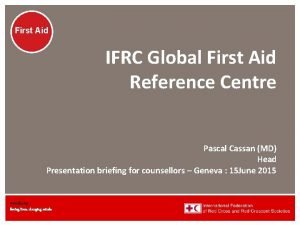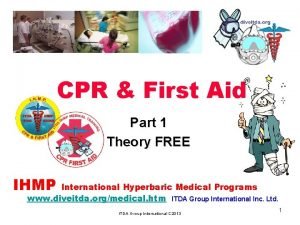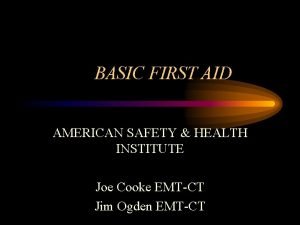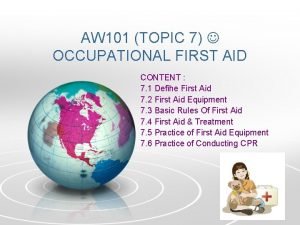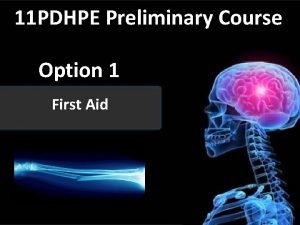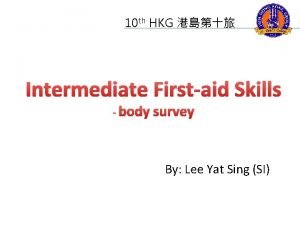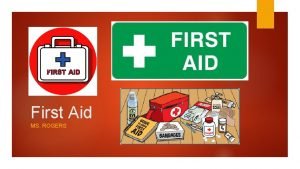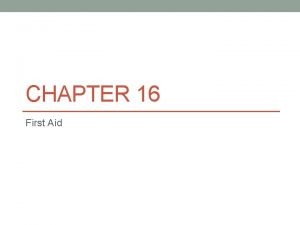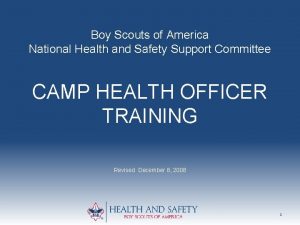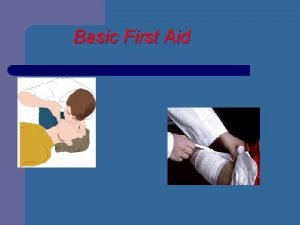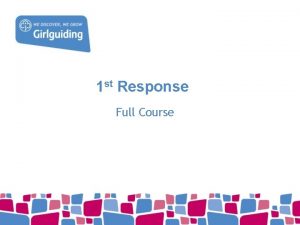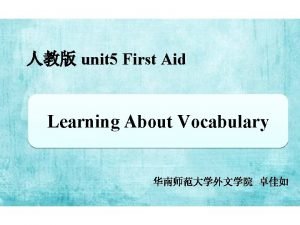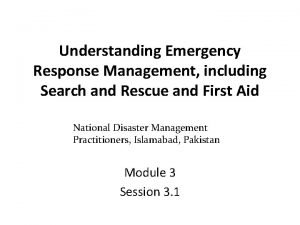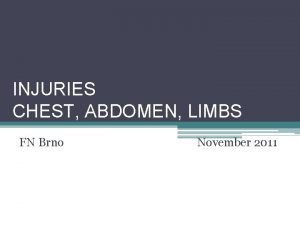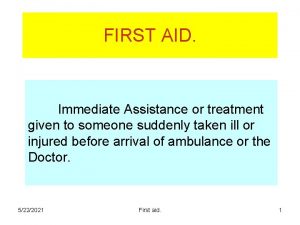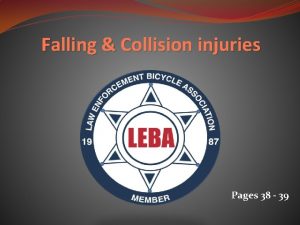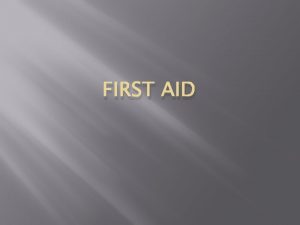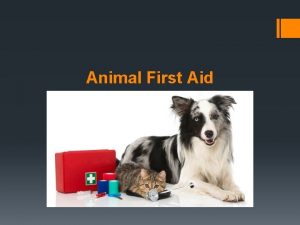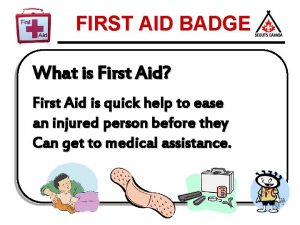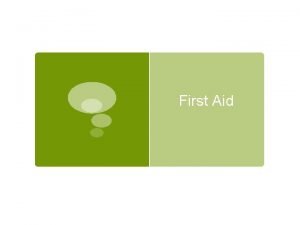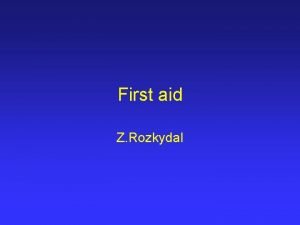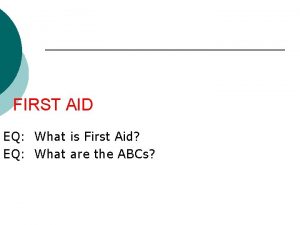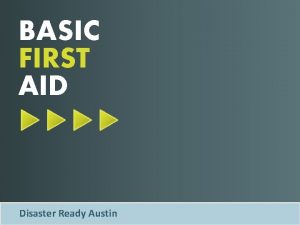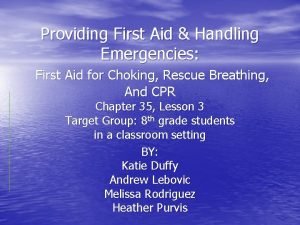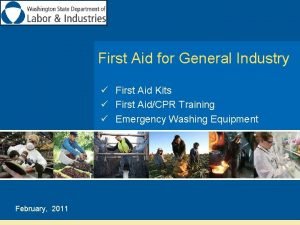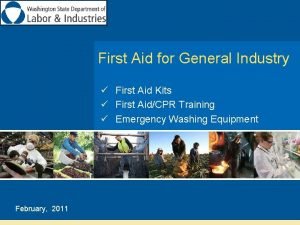Youth First Aid Youth First Aid The aim

![青年急救課程 Youth First Aid • 希望透過本課程,紅十字會青年團會員不單只能認識基本 急救常識及處理技巧。在課程完畢後,會員能在校內的急 救服務中擔任急救員,並能在公開急救服務中協助成人團 會員實踐[保護生命和健康]的紅十字會使命 • The aim of this 青年急救課程 Youth First Aid • 希望透過本課程,紅十字會青年團會員不單只能認識基本 急救常識及處理技巧。在課程完畢後,會員能在校內的急 救服務中擔任急救員,並能在公開急救服務中協助成人團 會員實踐[保護生命和健康]的紅十字會使命 • The aim of this](https://slidetodoc.com/presentation_image_h/98f50861342a325aabd89b4af377fe7b/image-2.jpg)






















































































































- Slides: 120

青年急救課程 Youth First Aid
![青年急救課程 Youth First Aid 希望透過本課程紅十字會青年團會員不單只能認識基本 急救常識及處理技巧在課程完畢後會員能在校內的急 救服務中擔任急救員並能在公開急救服務中協助成人團 會員實踐保護生命和健康的紅十字會使命 The aim of this 青年急救課程 Youth First Aid • 希望透過本課程,紅十字會青年團會員不單只能認識基本 急救常識及處理技巧。在課程完畢後,會員能在校內的急 救服務中擔任急救員,並能在公開急救服務中協助成人團 會員實踐[保護生命和健康]的紅十字會使命 • The aim of this](https://slidetodoc.com/presentation_image_h/98f50861342a325aabd89b4af377fe7b/image-2.jpg)
青年急救課程 Youth First Aid • 希望透過本課程,紅十字會青年團會員不單只能認識基本 急救常識及處理技巧。在課程完畢後,會員能在校內的急 救服務中擔任急救員,並能在公開急救服務中協助成人團 會員實踐[保護生命和健康]的紅十字會使命 • The aim of this course is to equip the Red Cross Youth (RCY) members with basic knowledge and procedures of first aid. After the completion of this course, members can be first aider in school first aid service and assist adult first aider in public first aid service, so as to actualize the mission [Protecting life and health] of the Hong Kong Red Cross (HKRC). 2

青年急救課程 Youth First Aid • 時間 • Course Duration – 共六節,每節2小時( – 12 hours: 6 sessions, 2 hours per 共十二小時)。 session • Those who have attended at • 凡出席不少於五節 least 5 sessions are eligible to 者均可參加考試 • 考試 – 筆試 - 50題(答對25 題或以上為合格) – 實習試 - 出血傷者處理(6分鐘) - 骨折傷者處理(6分鐘) join the examinations • Assessment – Written examination – 50 questions (Passing score is 25 correct answers) – Practical examination - Bleeding treatment (6 mins) - Fracture treatment (6 mins) 3

學習目標 Objectives • 第一節 – – – – • Session 1 – Tell the definition and aims of first 說出急救的定義和目的 aid 列出救治的程序 – Tell the procedure of first aid 描述出初步檢查的程序和 – Tell the procedure and importance 重要性 of victim assessment 找出撓動脈和頸動脈位置 – Locate radial artery and carotid artery 說出生命表徵的正常讀數 述說出對成人哽塞傷病者 – Tell the normal vital signs – Describe choking treatment for 的處理 adult 完成大手掛、三角手掛的 – Perform arm sling and elevation 包紮 sling 4

紅十字與急救 Red Cross & First Aid 5

紅十字標誌的應用 The usage of red cross emblem • • 白底襯托的紅十字標 誌是代表紅十字運動 或在戰亂時作為保護 性的標誌。濫用這標 誌可被檢控。 而應可的急救標誌, 是一個用綠底襯托的 白十字標誌。 • The Red Cross on white background represents Red Cross Movement or is the protection symbol during wartime. Unauthorized use of emblem will be prosecuted. • A green cross on white background is an authorized symbol of first aid. 6

急 救?? What is first aid? • 當意外或急症發生時,在正式醫 護人員未到達現場之前,利用現 場所提供之人力及物力為傷病者 或急症病者提供援助,而這些協 助必須符合基本醫學技巧。 • When an accident occurs, before the arrival of health care professionals, use the available resources (labour and material) at the scene to help the victim based on medical principles. 7

急救目的 Objectives of first aid • 維持生命 • 防止傷勢或病情惡化 • 促進復原 • Preserve life • Prevent worsening of condition • Promote recovery 8

急救人員的責任 Responsibilities of first aider 1. 2. 3. 4. 迅速評估現場安全情 況 迅速辨認出傷患者的 即時危險 尋求協助 利用曾學習之知識及 技巧小心處理傷患者 1. 2. 3. 4. Ensure safety of the scene Find out life-threatening condition of victim as soon as possible Call for help Help victim based on medical principles 9

急救程序(初步檢查) First aid procedure (Primary check) (D R A B C D E) • Danger - 個人安全 – 確保自己、傷病者及途人的安全 – 避免感染疾病 • Danger – Ensure safety of first aider, victims and passer-by – Avoid infection 10

為減低感染機會,急救員應執行標準防感染程序: Protect yourself from infection Follow infection control procedure: • 戴上用後即棄的保護性手套 • 避免被傷病者身上或現場的尖銳物品刺傷, 例如刀片及玻璃碎片 • 戴上口罩 • 處理嚴重出血如動脈撕裂的出血傷病者時, 應戴上保護眼罩 • Wear disposable protective gloves • Be careful of sharp objects on victim or at the scene, e. g. glass, blade • Wear mask • Wear goggles when treating victim with arterial bleeding 11

為減低感染機會,急救員應執行標準防感染程序: Protect yourself from infection Follow infection control procedure: • 在進行人 呼吸時,使用人 呼吸面膜或 袋裝面罩 • 在處理傷病者後,使用清潔液清潔雙手,清洗和消毒急救 儀器 • 清洗雙手前,避免接觸自己身體及個人物品 • Use pocket mask or face shield when giving artificial ventilation • Wash hands with soap and water and disinfect equipment after treating victim • Do not touch yourself or your things before washing your hands 12

DRABCDE • Response - 傷病者的反應 – 先在傷病者耳邊大聲呼喚,並輕拍其肩膊,以 測試其反應 – 請求旁觀者協助及安排搶救 作 • Response – Check response by calling victim next to the ears and tapping on the shoulders – Ask for help and arrange treatment 13

• Airway - DRABCDE 氣道 – 打開氣道 • Breathing - 呼吸 – 以視、聽、觸之方法檢查傷病者是否仍有呼 吸(不多於 10秒) • Airway – Open and clear airway • Breathing – Check for normal breathing by looking, listening, feeling (<10 s) 14

DRABCDE • Circulation - 血壓循環 – 檢查血液循環徵象 – 制止嚴重出血 • Circulation – Check signs of circulation – Management severe external bleeding 15

DRABCDE • Disability - 失去能力 – 檢查傷病者的清醒程度 • Expose - 展露傷病者之傷勢 – 展露傷病者之受傷部位以接受進一步評估和 治療 • Disability – Check level of consciousness • Expose – Expose for further assessment and treatment 16

急救優先次序 Priorities of care 1. 2. 3. 4. 5. 窒息 (Suffocation) 人事不省 (Unconsciousness) 大量出血 (Bleeding) 燒傷、燙傷 (Burn & scald) 骨折 (Fracture) 17


Vital signs Adult (>age 8) Body temperature Child (age 1 -8) Infant (<age 1) 36. 2℃ 37. 5℃ (97. 2℉ 99. 5℉) Pulse (per min) 60 100 80 120 140 Breathing (per min) 12 20 16 30 20 40 Skin condition should be pink (red) warm dry 19

哽塞 Choking • 某些物件阻塞在氣道內(異物阻塞氣道),導致 空氣無法進入肺部,而影響正常呼吸,嚴重者可 引致死亡 • Any obstruction to the airway blocking air to enter the lungs, so air cannot enter the lungs and this affects breathing. It can lead to death. 20

哽塞 Choking • 原因 – 吞嚥體積過大的食 物 – 進食時談話、大笑, 導致食物阻塞氣道 – 體內酒精濃度過高, 如進食時飲酒,使 咳嗽的反射動作遲 緩 – 嬰兒、小孩誤吞異 物—如波子、豆、 糖果等 • Reasons – Swallowing a large piece of food – Talking or laughing when eating – High alcohol level lead to loss of gag reflex, like drinking wine when eating, leads to slow cough reflex – Foreign body ingestion in infants and children, for examples, bead, bean and candy 21

哽塞 - 徵狀 Symptoms of choking • • • 咳嗽,不管是劇烈還是微弱 單手或雙手緊握/抓著喉部 不能咳嗽、說話、大叫或是呼吸 驚慌 皮膚發紺(紫藍色) 如果不清除阻塞物會失去知覺,人事不省 Coughing, maybe loudly or weakly Clutching the throat with one / both hands Cannot cough, speaking, shout or breath Panic Cyanosis (bluish skin colour) May become unconscious if foreign body not be removed 22


哽塞 - 處理 Management of choking • 完全的(即不能咳嗽、說話、 大叫或是呼吸) – 施行『推腹法』 – 施行『拍背法』 • Complete(Cannot cough, talk, shout or breath) – Perform abdominal thrust – Perform back blow 24

青年急救課程 (溫習題) Youth First Aid (Revision) • 第一節 – 急救員進入災場前,應先考慮… – 替患者施行推腹法的位置為? – 國際急救標誌為. . . • Session 1 – Before entering the scene, first aider should consider… – Locate the position to perform abdominal thrust. – International first aid symbol is… 25

青年急救課程 (溫習題) Youth First Aid (Revision) • 第一節 – 正常成人脈搏每分鐘____ 次 – 三角手掛適用於承托那些受傷的部位? – 大角手掛適用於承托那些受傷的部位? • Session 1 – The normal pulse rate of an adult are _______ beats per minute. – Which injured parts need arm sling to support? – Which injured parts need elevation sling to support? 26

學習目標 Learning objectives • 第二節 – – – – 懂得處理輕微傷口 列出敷料的用途和種類 施行直接和間接止血方法 述出眼部受傷和異物入眼 及耳的處理 述出流鼻血和其他出血的 處理 認識休克的定義 處理休克傷者的臥姿 利用捲軸繃帶包紮出血部 位 • Session 2 – Treat minor wound – Tell different kinds and usages of dressing – Perform direct pressure and indirect pressure – Tell how to handle eye trauma and foreign body in ear – Describe how to handle nose bleeding and other bleedings – Tell the definition of shock – Tell the recovery position for shock victim – Use roller bandages to treat wounded parts 27

止血法—直接加壓止血法 Bleeding control – Direct pressure • 直接在傷口加壓止血 – 首先應該使用的控制出血的方法 • 它是最 – 快速、 – 有效及 – 簡單之止血法。 • Press directly on the bleeding area – The first bleeding control method to be used • The quickest, simplest and most effective way. 28

止血法—直接加壓止血法 Treatment of bleeding – Direct pressure • 用力直接按壓出血處,並保 持足夠壓力於傷口上 • Press firmly and directly on the bleeding area 29

止血法 Bleeding control 如可能,先穿保護性手套 Wear protective gloves before helping the victim • 間接壓法 – 在傷口周圍施加壓力 • Indirect pressure – Press around the bleeding area 30

止血法 Bleeding control 如可能,先穿保護性手套 Wear protective gloves before helping the victim • 固定傷處 – 制止傷處活動 • Fix the injured part – Immobilize injured part 31

敷料用途 Usages of dressing • • 吸收滲出血液及體液 遮蓋及保護傷口 防止細菌入侵 幫助止血 • • Absorb blood and body fluid Cover and protect the wound Prevent infection Help stop bleeding 32

繃帶用途 Usage of bandage • 使敷料保持直接壓力於 傷口上,以制止出血 • 固定敷料或夾板 • 支持受傷的肢體或關節 • 避免受傷部位的移動 • 減低腫脹 • 幫助運送傷者 • Put the dressing on the wound apply pressure on it to stop bleeding • Hold the dressing or splint • Support injured limb or joint • Restrict injured part to move • Reduce swelling • Help to transport victim 33

傷口處理(1) Wound management (1) • 讓傷病者 – 坐下 或 – 臥下休息 • Ask the victim to – Sit OR – Lie down 34

傷口處理(2) Wound management (2) • 展露傷口,檢查是否有異物 • Expose the wound and check if there is any foreign object 35

傷口處理(3) Wound management (3) • 用大量流動清水(自來水)灌洗傷口 • 穿戴保護性手套,用敷料覆蓋傷口,施行直接壓 法止血 • Wash the wound with running water • Wear protective gloves. • Put dressing on the wound and perform direct pressure bleeding control 36

傷口處理(3) Wound management (3) • 包紮傷口 • 檢查遠端血液循環 • 預防或處理休克 • Bandage the wound • Check the distal circulation after bandaging • Prevent or treat shocking 37

傷口處理 - 注意 Wound management – Points-to-note • 除敷料外,切勿使用其他物 品止血(如煙絲、止血散等) • 傷口若有鬆浮的異物(如泥 沙),或其他污染物,可用 消毒生理鹽水或清水沖洗後 再依上圖方法處理 • Besides gauze, never use other things to stop bleeding, e. g. , tobacco, powder • If wounds are contaminated e. g with soil, use normal saline or running water to clean the wound as illustrated above 38

鼻孔出血 - 處理 Nose bleeding - Treatment • • • 使傷者坐直,頭略向前傾,冷敷額部 用手指緊捏鼻樑柔軟部份約10分鐘 指導傷病者用口呼吸 若仍出血,繼續緊捏 10分鐘 若仍出血,可重覆動作 1次 若 30分鐘內仍不能止血,速送醫院 • • Sit down and with head leaning forward Apply a cold pack on forehead Pinch the nose just below the bridge for about 10 minutes Ask the patient to breath through the mouth If bleeding continues, pinch another 10 minutes Repeat the steps once only Send to hospital if bleeding continues for >30 minutes 39

眼部受傷 - 種類 Types of eye trauma • 異物入眼 • 眼部受傷 • 化學品燒傷 • Foreign object in eyes • Injury • Chemical burn 40

眼部受傷 - 處理原則 Management of eye trauma • 急救員必須先戴上保護性手套 – 以防傷病者受感染 • 切勿於眼睛上施壓 – 包括擦眼、咳嗽、打噴嚏 • 切勿試圖抹去血液或血塊 • First aider must wear protective gloves – To protect patient from being infected • Do not press the eye – Do not rub the eye, cough or sneeze • Never try to remove blood or clot 41

眼部受傷 - 處理原則 Management of eye trauma • 包紮時應將雙眼遮蓋 – 以免影響受傷眼球的活動 • 防止眼部受壓 – 如有需要,可用洗眼杯或袋裝面罩放在受傷的眼上 • 急救員擬作任何步驟前,應先向傷病者解釋 • Cover both eyes by dressing – avoid movement of the injured eye • Protect the eye – Put eye bath/ pocket mask on the injured eye • First aider should explain to the patient before doing anything 42

異物入耳 - 處理 Management of foreign object in ear • 切勿試圖取出 • 速送院醫 • Never try to remove it • Send to hospital ASAP 43

休克 Shocking • 因為血液循環減弱或衰竭,使細胞灌流不 足,致腦部及身體重要器官缺氧,嚴重者 缺氧 可導致不省人事,甚至死亡 • 血壓低是休克後期徵狀 • Inadequate oxygen supply to brain and other vital organs due to low blood flow or poor blood circulation • May cause coma or even death • Low blood pressure is a sign of late stage of shock 44

休克徵狀 Signs and symptoms of shocking 1. 初始階段 – 脈搏稍快 2. 1. Initial stage – Pulse rate increases 2. Compensatory stage – Rapid pulse 補償階段 – Fast and swallow breathing – 脈搏速率加快 – Cold and wet skin – 呼吸淺促 – Anxious – 皮膚濕冷 – Reduce urine output – 焦慮 – 尿液減少 45

休克徵狀 Signs and symptoms of shocking 3. 進行性階段 3. Progressive stage 4. 難治階段 4. Refractory stage – 血壓下降 – 神智不清 – 缺尿 – 血壓極低 – 人事不省 – 器官衰竭 – 死亡逼近 – Low blood pressure – Confusion – No urine – Low blood pressure – Coma – Organs failure – Near death 46

1. 2. 3. 4. 休克 – 處理(1) Treatment of shock (1) D. R. A. B. C. D. E. 速送醫院 制止外出血 蓋氈保暖,但勿使傷 病者過熱 5. 禁止飲食 6. 密切檢查清醒程度、 呼吸及血液循環表徵 1. 2. 3. 4. 5. 6. D. R. A. B. C. D. E. Send to hospital ASAP Stop external bleeding Keep warm with blanket, prevent overheated No eating or drinking Closely monitor the level of consciousness, breathing and circulation 47

休克 – 處理(2) Treatment of shock (2) 7. 安慰傷病者,安置 7. Comfort the patient 傷病者仰臥。如有 and lie him face up. If 需要,可鬆解頸、 needed, loose tight 胸或腰部緊身衣物 clothing on neck, chest or waist 8. 在可行情況下,切 勿單獨留下傷病者 8. If possible, never leave the patient alone 48

青年急救課程 (溫習題) Youth First Aid (Revision) • 第二節 – 處理流鼻血傷者時應. . . – 繃帶用途為. . . – 敷料應該是. . . – 何時使用間接壓法止血 – 休克的定義為. . . • Session 2 – How to treat a nose bleeding casualty? – What are the usages of bandage? – What can be dressings? – When do we use indirect pressure bleeding control? – What is shock? 49

學習目標 Learning objectives • 第三節 – 認識昏厥的徵狀和處理方法 – 描述出進一步檢查的程序和 重要性 – 認識四個不同清醒程度和特 徵 – 處理昏迷傷者和擺放復原臥 式 – 認識不同種類的燒傷和燙傷 – 說出燒傷不同程度損害的計 算方法 – 說出輕微程度的燒傷和燙傷 處理方法 • Session 3 – Learn the symptoms, signs and treatment of syncope – State the process and importance of head to toe assessment – Learn 4 levels and signs of consciousness – Learn recovery position – Learn different types of burns and scalds – Calculate area of burn – Tell the treatment for minor burns and scalds 50

昏厥 Syncope • 因流入腦部的血液突然暫時減少而引起,通常不 會超過幾分鐘,視乎病因,傷病者一般可迅速完 全復原 • Caused by transient decrease in blood supply to brain, patients usually recover within minutes. 51

• 觸發原因 昏厥 Syncope – 驚恐、壞消息、情緒激動、疼痛或不快刺激 – 長時間身體缺少活動,如坐或站太久,血液集中在身體下 半身 – 運動過度、體力衰竭、疲倦、飢餓 – 穿著過重及過緊的衣服 (酷熱天氣、酒精或傷病者有貧血都會增加昏厥的機會) • Causes – Panic, bad news, excited, pain or negative stimuli – Immobilized for long time due to pooling of blood in lower limbs – Too much exercise, fatigue, tiredness, hunger – Wear heavy or tight clothing (Very hot weather, alcohol and anemia may increase the possibility of syncope) 52

昏厥 Syncope 徵狀 • 眩暈 • 噁心、嘔吐 • 面色蒼白 • 面額及手出汗 • 耳鳴 • 神智不清 • 嚴重會短暫昏迷 Signs and symptoms • Dizziness • Nausea and vomiting • Pallor • Face and hand sweating • Tinnitus • Confusion • A short coma if critical 53

昏厥 - 處理 Treatment of syncope • • • 安置傷病者坐臥或仰臥休息 鬆解緊身衣物 鼓勵傷病者作深呼吸 確保周圍空氣流通 如壞疑並非普通昏厥,速送醫院 Help patient to rest by sitting or lying down Loose tight clothing Encourage deep breathing Ensure there is fresh air Send to hospital at once if in doubt 54

人事不省-原因 Causes of unconsciousness 有很多個醫學的原因,例如: • 疾病 - 癲癇、糖尿病的緊急情況、尿毒症、感染、 精神病、中毒、中風 • 創傷 • 其他—酒精、曝露、用藥過量或缺氧 Many medical causes, e. g. : • Sickness – Epilepsy, critical situation of diabetes, uremia, infection, mental sickness, poisoning, stroke • Trauma • Others—alcohol, exposure, drug overdose or not enough oxygen 55

人事不省 Unconsciousness • 因腦部功能發生障礙而引致的結果 Result caused by brain function problem 清醒程度 Level of consciousness • A • V • P • U Alert and Oriented 完全清醒 Verbal 對聲音有反應 Pain 對痛楚有反應 Unresponsive 全無反應(昏迷) 56

人事不省 - 危險性為 Danger of unconsciousness • 舌倒後引致窒 • Fall back of tongue lead to suffocation 57

人事不省 - 處理方法 Treatment of unconsciousness • D. R. A. B. C. D. E • 檢查傷病者,找出引起人事不省的原因 立即依照其緊急情況而作出適當處理 • 確定沒有其他嚴重傷勢 • D. R. A. B. C. D. E • Perform head-to-toe assessment to find out the cause of unconsciousness Treat the cause immediately • Check if there is other serious injury 58

人事不省 - 處理方法 Treatment of unconsciousness • • • 處理有關傷勢 再次打開氣道,檢查呼吸 將傷病者安置於『復原臥式』 每分鐘檢查清醒程度、呼吸及血液循環表徵 速送醫院 Deal with related injury Open airway again and check breathing Place the victim in recovery position Check level of consciousness, breathing and circulation every minute • Send to hospital at once 59

全身檢查 Head-to-toe assessment • • • 頭部 頸部 胸部 腹部 背部 肢體 Head Neck Chest Abdomen Back Limbs 60

復原臥式 Recovery position 預防舌 倒後 Preve nt th e fa l back l of to ngue 出 排 吐物 嘔 便 方 to s u t i r vom o f r e i Eas t u o e com 61

燒傷及燙傷 Burns & scalds • 由熱力引起 Caused by heat • 可引致皮膚功能受損、細菌感染及體內液體流失而導致休克 Shock due to fluid loss 表皮 Epidermis 毛幹 Hair shaft 真皮 Dermis 肌肉層 Muscle 血管/ 神經末梢 Blood vessel/ nerve end 脂肪 Fatty tissue 62

燒傷及燙傷 Burns & scalds • 種類 – 燒傷 • 如火、熱的物品、摩擦等所造成的傷害 – 燙傷 • 如沸水、蒸氣、滾油等所造成的傷害 • Types – Heat burn • E. g. Injury caused by flame, hot object or friction – Scald • E. g. Injury caused by boiling water, steam, boiling oil 63

燒傷及燙傷 Burns & scalds – 其他 • • 電燒傷,如低壓電、高壓電、雷擊等 化學品燒傷,如強酸、強鹼等 低溫灼傷,如乾冰、液化氮等 輻射燒傷,如放射性物質、太陽曬傷等 – Others • Electric burn, e. g. low or high-voltage current, lightning • Chemical burn, e. g. strong acid or alkali • Cold injury, e. g. dry ice, liquid nitrogen • Radiation burn, e. g. radioactive substance, sunburn 64

燒傷及燙傷 Burns & scalds • 所引致的情況 – 皮膚功能受損 – 細菌感染 – 流失體內液體 – 休克 • Impact of burns – loss of protective function of skin – Infection – Body fluid loss – Shock 65

燒傷深度計算 Depth of burns 第一程度(表層) 1 st degree burn (Superficial burn) • 只傷及皮膚的表面,通常會造成 紅、腫及觸痛 • Only involve the epidermis of skin, usually red, swollen and sore to touch 66

燒傷深度計算 Depth of burns 第二程度(中層) 2 nd degree burn (Partial-thickness burn) • 皮膚損傷已深入真皮,但尚未穿透真皮,引致紅腫、劇痛 及起水泡 • 不過,傷處的神經末梢並未全部損害,因此傷處周圍往往 特別疼痛 • Involve part of dermis, red, swollen and very painful skin with blister. • Nerve endings are intact, so it is painful around the wound. 67

燒傷深度計算 Depth of burns 第三程度(深層) 3 rd degree burn (Full-thickness burn) • 皮膚完全被破壞,傷處乾燥 • 燙傷傷處顯得蒼白、燒傷傷處甚至焦黑 • 由於傷處周圍的神經亦被破壞,因此傷處可能沒有痛 楚感覺。 • Skin is totally damaged. • Dry wound can be white or burned black. • There may be no pain because nerve ends are damaged. 68

輕微燒傷 - 處理 Treatment for minor burns and scalds • 用流動的清水(例如自來水)沖洗傷 口至無痛楚感覺 • 抹乾傷口 • 避免不必要之碰撞,以免擦傷傷口 • Running water, e. g. tap water, over the wound until the pain is relieved • Dry the wound • Avoid touching or scratching

燒傷處理禁忌 Cautions 刺穿水泡 撕去黏連的衣物 塗抹或結予任何藥物 冰敷傷處給予飲食 將傷病者過度降溫 Break the blisters Remove clothing stick on the wound Apply lotion or give medicine to the victim Apply ice to the wound or offer food or drinks Excessively cool down the victim

化學物品燒傷 Chemical burn 在處理傷病者前應穿戴保護性衣服,口罩和手套 Wear protective clothing, mask and gloves before treating the victim 皮膚接觸強酸或強鹼 Caused by skin contact of strong acid or alkali 而引致 • 處理 – 用流動的清水(例如自 來水)沖洗傷處,直至 醫護人員到場 – 小心除去沾有化學物品 衣物 – 處理其他損傷,如止血 – 速送醫院 • Treatment – Running water, e. g. tap water, over the wound until health care professionals arrive – Remove contaminated clothing carefully – Treat other injuries, e. g. stop bleeding – Send to hospital ASAP

嚴重燒傷 Serious burns • 第三程度燒傷 • 呼吸氣道、面部、手掌、腳掌及生殖器官燒傷 • 肢體或軀幹環形的燒傷 • 3 rd degree burn • Airways, face, palm, the sole of the foot and reproductive organs are burned • Circumferential burns involving limbs and trunk

嚴重燒傷 Serious burns • 傷病者是長者、年幼及患病之人士燒傷 • 任何由化學藥物或觸電而導致的燒傷 • 10%或以上的皮膚面積被燒傷 • The victim is at extreme of age (e. g. elderly, infant) or with chronic illness • Burns caused by chemical or electricity • 10% or more of burn

青年急救課程 (溫習題) Youth First Aid (Revision) • 第三節 – 清醒程度可分為. . . – 復原臥式有甚麼優點? – 將傷者安置於復原臥式後,你應每分鐘 檢查那些項目? • Session 3 – Levels of consciousness are. . . – What are the advantages of recovery position? – After placing the victim in recovery position, what should you check every minute? 74

青年急救課程 (溫習題) Youth First Aid (Revision) • 第三節 – – 燒傷深度計算程序分為. . . 輕微燒傷處理方法為… 燒傷及燙傷定義為… 何為嚴重燒傷 • Session 3 – – Ways to kwon degree of burn is. . . Treatment of minor burn is. . . Definition of burn and scald is. . . What is a serious burn? 75

學習目標 Learning objectives • 第四節 – 說出各類肌肉、關節損傷的成因和徵狀 – 認識肌肉、關節損傷的處理方法 • Session 4 – Tell the causes and signs of different muscle and joint injuries – Learn the treatment of muscle and joint injuries 76

肌肉抽筋 Muscle cramp • 肌肉突然不自主地收縮和疼痛,原因有很 多,如熱身不足、受寒、水份不足及電解 質失調等 • Muscle pain and spasm • Causes included: Not enough warm-up exercises, coldness, not enough water or salt 77

肌肉抽筋 Muscle cramp • 徵狀 – 肌肉疼痛有硬實和痙攣的感覺 – 傷病者無法鬆弛已收縮的肌肉 – 肌肉牽動的關節不能活動自如 • Signs – Muscle pain, stiffness and spasm – Can’t relax the contracted muscle – Can’t control related joint 78

肌肉抽筋 - 處理方法 Treatment of muscle cramp • 使傷病者保持鎮靜,按摩抽筋部 位或用伸展的方法使肌肉鬆弛 • Comfort the victim, massage the affected muscle or extend to relax the muscle 79

肌肉抽筋 - 處理方法 Treatment of muscle cramp • 伸展肌肉,例如: – 小腿:將足部壓向頭部位置 – 大腿:屈曲膝部 – 足部:將足趾伸直踏一下 • Extend the muscle, e. g. – Calf : Flex the ankle towards the head – Thigh:Bend the knee – Foot:holding tip toe on ground 80

肌肉拉傷 Muscle strains • 當肌肉因 作過度牽拉導致部份纖維斷裂 • 徵狀: – 肌肉突感疼痛,行動時痛楚加劇 – 肌肉可能腫脹及發生劇烈痙攣,若是肌肉受傷, 傷病者會不能站立或端坐 • The muscle is overstretched and some of the fibers are torn • Signs and symptoms: – Sudden start of muscle pain, more painful when moving – Swelling and spasm – If muscle is injured, the victim may not able to stand or sit properly

肌肉拉傷 Sprain • 由於突然過度的扭力將韌帶部份撕裂,但骨 骼並無脫位 • 徵狀 – 疼痛 – 雖然活動困難但仍能作有限度的活動 – 亦無變形 • Some ligaments are torn by sudden strong twisting force. No dislocation. • Signs – Pain – Can still make limited movement – No deformities 82

肌肉拉傷/關節扭傷 - 處理 Treatment of muscle and joint injuries • Rest - 休息受傷部份 Rest the injured part • Ice - 冷敷受傷部份 Cold compress applied to the injured part • Compression 壓包紮 - 用繃帶固定受傷部份及加 Fix and compress with bandage • Elevation - 將受傷部份承高,以減少腫脹 83

關節脫位 Joint dislocation • 徵狀 – – 受傷部位變形或縮短 受傷關節部份劇痛,故該部份的關節不能活動 腫脹和瘀傷 如肢體末端出現麻痺、癱瘓或沒有脈搏,表示神經線 或血管可能受壓 • Signs – – Joint deformed or shortened Very painful, unable to move the injured joint Swelling and bruise If distal part is numb, paralyzed or show no pulse, nerve or blood vessel may be compressed 84

關節脫位 Joint dislocation • 處理方法 – 必須停止一切活動 – 盡量避免移動肢體,切勿試圖將脫位部份復位 – 用大量物料襯墊使傷病者坐臥舒適,並固定脫位部份 – 召喚救援 – 若脫頜骨,用繃帶承托下頜,在健側打結 • Treatment – – – Stop moving Avoid moving the injured limb. Don’t try to relocate Immobilized the injured part Send to hospital In case of fracture jaw, use bandage to support the jaw with knot on non fracture side 85

青年急救課程 (溫習題) Youth First Aid (Revision) • 第四節 – 肌肉拉傷徵狀為… – 處理肌肉拉傷/關節扭傷的程序為… – 肌肉抽筋的處理方法為… • Session 4 – Signs of muscle strains are… – Treatment of muscle/ joint injuries is… – Treatment of muscle cramp is… 86

學習目標 Learning objectives • 第五節 – – – 認識導致骨折的原因 列出骨折的種類 說出一般骨折的徵狀和處理原則 下頷骨、上臂、前臂、手腕骨骨折的處理方法 骨折部位在包紮前和處理後所需要的檢查 • Session 5 Learn the causes of fracture List different types of fracture Learn signs and treatment of common fracture Learn the treatment of lower jaw, upper arm, forearm, wrist fracture – Learn the checking before and after fracture bandaging – – 87

骨折原因 Causes of fracture • 直接暴力 Direct force – 骨折發生於受力之處 – Caused by direct contact • 間接暴力 Indirect force – 骨折發生於非受力之處 – Caused by indirect contact rather than forced area • 肌肉牽拉 Muscle pull – 肌肉之動作與骨之活動成反方向所 引致 – Happened when muscle and bones move in opposite directions 88

骨折 - 種類 (1) Types of fracture (1) • 閉合骨折 Close fracture - 軟組織輕微損傷(單純骨折) - Mild injury to soft tissue (Simple fracture) - 軟組織嚴重損傷(複雜骨折) - Serious injury to soft tissues (Complex fracture) 89

骨折 - 種類 (2) Types of fracture (2) • 開創骨折 Open fracture • 軟組織輕微損傷 • Mild injury to soft tissues • 軟組織嚴重損傷 • Serious injury to soft tissues

骨折 - 種類 (3) Types of fracture (3) • 青枝骨折 Green-stick fracture – 只見於兒童,形容骨之一側斷裂但另一側完 好或折曲的骨折 – Only happen to children. Fracture involved only one side of the bone cortex 91

骨折 - 徵狀 Signs of fracture • • • 觸痛和劇痛 腫脹 可能有瘀傷 傷肢無力 傷肢變形、參差不齊或縮短 • • • Painful to touch and painful Swelling May have bruise Injured limb is difficult to move Deformed, irregular, shortened injured limb 92

骨折 - 徵狀 Signs of fracture • 骨折處失去活動能力 • 骨折附近關節失去活動能力 • 傷病者可能因骨折部位有大量出血而產生休克 • Injured part can’t move • Joints near injured part can’t move • Victim may suffer from serious bleeding due to fracture and shock may develop 如有懷疑時,當骨折處理 If in doubt, treat it as fracture. 93

骨折固定法基本原則(一) Basic principle of fixing fracture 1 如可能,先穿保護性手套 If possible, wear protective gloves before helping the victim • D. R. A. B. C. D. E. • 置傷病者於適當位置,然後立即施救 • 切勿隨便移動骨折處 (除非現場環境對傷病者或急救員的安全有威脅) • D. R. A. B. C. D. E. • Help the victim to rest in a comfortable position • Avoid moving the injured part (Only if the scene is not safe to the victim and the first aider) 如為開創骨折,應先用間接壓法止血 If it is an open fracture, indirect pressure should be applied to control bleeding 94

骨折固定法基本原則(一) Basic principle of fixing fracture 1 如可能,先穿保護性手套 If possible, wear protective gloves before helping the victim • 檢查傷肢遠端血液循環、皮膚感覺及活動能力 • 當傷病者仰臥時,可在人體天然凹位 (頸、足踝、膝、腰) 穿過三角巾 • 包紮下肢時,除足踝外,其餘均用闊帶固定 • Check circulation, sensation and movement of the distal part of the injured part • With the victim lying down, pass the bandage via nature gap of body (neck, ankle, knee and waist) • When bandaging legs, using wide triangular bandage, except for ankle 95

骨折固定法基本原則(二) Basic principle of fixing fracture 2 如可能,先穿保護性手套 If possible, wear protective gloves before helping the victim • 在適當位置放置軟墊: • Put cushions at suitable positions: – – 夾板與肌肉間 關節間 骨隆突處 骨折處 – – Between splint and muscle Between joints Knuckles Fracture part 如為開創骨折,應先用間接壓法止血 If it is an open fracture, indirect pressure should be applied to control bleeding 74

骨折固定法基本原則(二) Basic principle of fixing fracture 2 如可能,先穿保護性手套 If possible, wear protective gloves before helping the victim • 足夠承托及利用健側作固定 • 包紮時力度均勻,動作輕快 • 包紮完成後應頻密檢查遠端血液循環、皮膚感覺及 活動能力 • Provide enough support and splint against the normal side • Consistent force. Handle the fracture gently and avoid unnecessary movement when bandaging • After bandaging, check circulation, sensation and movement of the distal part of the injured part 74

青年急救課程 (溫習題) Youth First Aid (Revision) • 第五節 – 骨折成因為… – 骨折種類可分為… – 骨折一般處理程序為… • Session 5 – Causes of fracture are… – Types of fractures are… – Treatment of common fractures are… 98

學習目標 Learning objectives • 第六節 – 認識動物相關的健康問題 – 認識熱衰竭及中暑 – 手指骨、手掌骨、鎖骨骨折的處理方法 • Session 6 – Learn health problem related with animals – Learn heat exhaustion and heat stoke – Learn the treatment of finger, palm, collar bone fracture 99

咬傷的處理(哺乳類動物) Animal bite management (Mammals) 1. 盡速用大量清水,生理鹽水或肥皂水灌 洗傷口,以減低受細菌感染機會 2. 若傷口出血,可用敷料於傷處直接施加 壓力止血,然後用消毒紗布遮蓋傷口及 包紮固定 1. Running water/ saline/ soap water over the wound to avoid infection 2. Stop bleeding by applying direct pressure and bandage the wound 100

咬傷的處理(哺乳類動物) Animal bite management (Mammals) 3. 由於動物(如貓和狗)牙齒帶有很多細 菌,不論傷口大小,應立即前往附近的 急症室治理,醫護人員會按情況安排手 術、接種預防破傷風和瘋狗症(狂犬病) 疫苗、藥物治療及傷口護理 3. As there is a lot of bacteria on animals’ teeth (e. g. cats and dogs), the victim should be sent to hospital asap. Medical professional may arrange operation, vaccination (tetanus and rabies), medication and wound management 101

昆蟲刺傷或咬傷的處理 Insect sting/ bite management 1. 如傷口上留有螫針, 用證件或咭片把傷口 上之螫針刮去或用眉 鉗拔去 1. Scrape the tick away with a card or remove it by eyebrow tweezers 102

昆蟲刺傷或咬傷的處理 Insect sting/ bite management 2. 用清水沖洗傷口 3. 可冷敷傷處以減輕痛楚及紓緩腫脹 4. 速送醫院 2. Run water over the wound 3. Cold compress can relieve pain and reduce swelling 4. Send to hospital at once 103

蛇咬 Snake bite 徵狀 • 傷口可能有明顯齒孔 • 被咬的部位感到發熱、 疼痛、腫脹 • 噁心、嘔吐 • 視覺模糊、頭痛 • 呼吸困難 Signs • Clear bite mark may be there • Increased temperature around the wound, painful and swelling • Nausea, vomiting • Blurred vision, headache • Difficulty breathing 104

蛇咬 - 處理(1) Snake bite management (1) • 保持鎮定並安慰傷病者 • 讓傷病者休息及不要移動傷肢,在安全的地方等 候救援 • Stay calm and comfort the victim • Let the victim rest and stop moving injured limb. Wait for help at safe place. 105

蛇咬 - 處理(1) Snake bite management (1) • 用大量清水沖洗傷口 • 若傷口出血,應先止血然後用消毒紗布遮蓋傷口 • 除去手環或指等束縛物 • Run water over the wound • If there is bleeding, stop bleeding and cover the wound with gauze • Remove constricted objects, e. g. rings, bracelets 106

蛇咬 - 處理(2) Snake bite management 2 • 觀察並認清蛇的形狀、顏色及其他可見的特徵 • 在安全的情況下,可嘗試為其拍照 – 切勿嘗試捕蛇及殺蛇 – 協助辨認何種毒蛇,有助醫生治理傷病者 • Observe the shape, colour and other characteristics of the snake • Take photo of the snake if it is safe – Don’t try to catch or kill the snake – Description of the snake helps doctor to know the type of snake and cure the victim 107

蛇咬 - 處理(2) Snake bite management 2 • 如蛇已死去,可把蛇屍連同傷病者帶到急症室識 別 – 切勿直接觸及屍體 • 注意傷病者有否出現休克徵狀,維持『A. B. C. 』 • 速送醫院 • If the snake dies, take it to the hospital with the victim for identifying type of snake – Don’t touch the snake directly • Watch out the signs of shock and maintain 『 A. B. C. 』 • Send to hospital at once 108

熱衰竭 Heat exhaustion • 在潮濕悶熱環境下或不習慣於非常酷熱天氣的 人,由於身體散熱時皮膚表面血管擴張而減低 血液循環的流量,加上出汗時流失大量水份及 鹽份,引致血液循環不足夠提供基本的養分給 予身體器官,導致休克 • People who are unaccustomed to very hot and humid environment. Due to dilation of blood vessels under skin surface, there is huge loss of salt and water through sweating. Reduction in blood volume leads to inadequate blood supply to vital organs, and subsequently shock.

熱衰竭 Heat exhaustion • 雖然此情況未及中暑般嚴重,但若未能及時察 覺或處理不當,傷病者情況可惡化為中暑 • Heat exhaustion is less serious than heat stroke. But if heat exhaustion is noticed or treated properly, it may develop to heat stroke.

熱衰竭-徵狀 Signs of heat exhaustion • • • 大量出汗 Excessive sweating 面青唇白 Pale skin 肌肉痙攣 Muscle cramps 疲勞和虛弱 Feeling tired and weak 頭暈 Dizziness 頭痛 Headache 噁心、嘔吐 Nausea and vomiting 昏厥 Syncope 皮膚濕冷 Cool moist skin 脈速而弱 Fast and weak pulse

熱衰竭 - 處理 Management of heat exhaustion • 移傷病者至陰涼處 • 除去傷病者衣物和用扇降溫,如傷病者體溫過高,可參 照中暑者之處理方法替傷病者降溫 • 但若傷病者出現震顫,應立即停止並遮蓋傷病者保暖 • Move the victim to shaded area • Remove clothing and use fun to cool the victim • If the body temperature is too high, refer to heat stroke management to cool the victim • If the victim shivers, stop cooling and cover the victim to keep warm

熱衰竭 - 處理 Management of heat exhaustion • 若傷病者清醒,應給予飲料以補充水份和鹽份 • 若傷病者神志不清,應依照休克處理,並安排 盡快送院治理 • If the victim is conscious, give suitable drinks with replenish water and salt • If the victim is confused, treat as shock and send to hospital at once

中暑 Heat stroke • 由於傷病者長時間處於非常酷熱環境下,身體散熱機能受影 響,例如未能利用出汗散熱,體內過量之熱力無法散發而導 致體溫上升 • 中暑可以導致多個系統組織和器官受損, 甚至死亡,所以需要緊急治療 • The temperature regulation mechanism (e. g. fail to sweat) is affected and body temperature raises because the victim has stayed in very hot environment for a long time • Heat stroke can cause multi-organ failure, even death, so send the victim to hospital at once

中暑 - 徵狀 Signs of heat stroke • • 傷病者皮膚潮紅、乾燥、無汗 體溫上升,可達至 41. 1℃或以上 脈搏急促 感到頭痛、暈眩或神智不清 • Flushed, dry skin, no sweating • Body temperature raises, can reach 41. 1℃ or higher • Rapid pulse • Headache, dizzy or confused

中暑 - 處理 Management of heat stroke • Move the victim to shaded • 移離傷病者至陰涼處 area • 維持『A. B. C. 』 • Maintain A. B. C. • 盡快為患者降溫 • Cool the victim as soon as – 除去衣物 possible – 先向傷病者灑水,再 – Remove clothing 用扇撥涼或吹風扇以 – Spray water and fan to 助水分揮發 help water evaporate – 可用濕有冷水的海綿 – Use sponge with cold to 連續抹身 wipe the skin – 在兩邊腋下及腹股溝 – Place sponge with cold 放置濕有冷水的海綿 water in armpits and groin area

中暑 - 處理 Management of heat stroke • 速送醫院 • 密切注意傷病者對降 溫之反應 • Send to hospital at once • Closely monitor the victim’s reaction to cooling • 留意處理的速度比處理的 方法更重要 速度 方法 • Speed of management is more important than way of cooling.

中暑/ 熱衰竭對比 Comparison of heat stroke and heat exhaustion 皮膚乾燥 Dry skin 皮膚濕冷 Cool moist skin 體溫非常高 體溫可能正常 Very high body temperature Body temperature maybe normal 無汗 No sweating 出汗 Sweating 皮膚潮紅 Flushed skin 面色蒼白 Pale skin 中暑 Heat stroke 熱衰竭 Heat exhaustion

個人急救袋 First aid kit

青年急救課程 (溫習題) Youth First Aid (Revision) • 第六節 – 中暑的徵狀為. . . – 熱衰竭的徵狀為. . . – 述出處理中暑和熱衰竭方法… • Session 6 – Signs of heat stroke are… – Signs of heat exhaustion… – Management of heat stroke and heat exhaustion are…
 First aid merit badge first aid kit
First aid merit badge first aid kit First aid aim
First aid aim First aid aim
First aid aim The legal aid board objectives
The legal aid board objectives First aid in the first grade
First aid in the first grade Neasden and greenhill park medical centre
Neasden and greenhill park medical centre Hát kết hợp bộ gõ cơ thể
Hát kết hợp bộ gõ cơ thể Bổ thể
Bổ thể Tỉ lệ cơ thể trẻ em
Tỉ lệ cơ thể trẻ em Chó sói
Chó sói Glasgow thang điểm
Glasgow thang điểm Chúa yêu trần thế alleluia
Chúa yêu trần thế alleluia Môn thể thao bắt đầu bằng từ đua
Môn thể thao bắt đầu bằng từ đua Thế nào là hệ số cao nhất
Thế nào là hệ số cao nhất Các châu lục và đại dương trên thế giới
Các châu lục và đại dương trên thế giới Công thức tiính động năng
Công thức tiính động năng Trời xanh đây là của chúng ta thể thơ
Trời xanh đây là của chúng ta thể thơ Cách giải mật thư tọa độ
Cách giải mật thư tọa độ Phép trừ bù
Phép trừ bù Phản ứng thế ankan
Phản ứng thế ankan Các châu lục và đại dương trên thế giới
Các châu lục và đại dương trên thế giới Thơ thất ngôn tứ tuyệt đường luật
Thơ thất ngôn tứ tuyệt đường luật Quá trình desamine hóa có thể tạo ra
Quá trình desamine hóa có thể tạo ra Một số thể thơ truyền thống
Một số thể thơ truyền thống Cái miệng nó xinh thế chỉ nói điều hay thôi
Cái miệng nó xinh thế chỉ nói điều hay thôi Vẽ hình chiếu vuông góc của vật thể sau
Vẽ hình chiếu vuông góc của vật thể sau Nguyên nhân của sự mỏi cơ sinh 8
Nguyên nhân của sự mỏi cơ sinh 8 đặc điểm cơ thể của người tối cổ
đặc điểm cơ thể của người tối cổ Thứ tự các dấu thăng giáng ở hóa biểu
Thứ tự các dấu thăng giáng ở hóa biểu Vẽ hình chiếu đứng bằng cạnh của vật thể
Vẽ hình chiếu đứng bằng cạnh của vật thể Phối cảnh
Phối cảnh Thẻ vin
Thẻ vin đại từ thay thế
đại từ thay thế điện thế nghỉ
điện thế nghỉ Tư thế ngồi viết
Tư thế ngồi viết Diễn thế sinh thái là
Diễn thế sinh thái là Các loại đột biến cấu trúc nhiễm sắc thể
Các loại đột biến cấu trúc nhiễm sắc thể Các số nguyên tố là gì
Các số nguyên tố là gì Tư thế ngồi viết
Tư thế ngồi viết Lời thề hippocrates
Lời thề hippocrates Thiếu nhi thế giới liên hoan
Thiếu nhi thế giới liên hoan ưu thế lai là gì
ưu thế lai là gì Hươu thường đẻ mỗi lứa mấy con
Hươu thường đẻ mỗi lứa mấy con Khi nào hổ con có thể sống độc lập
Khi nào hổ con có thể sống độc lập Hệ hô hấp
Hệ hô hấp Từ ngữ thể hiện lòng nhân hậu
Từ ngữ thể hiện lòng nhân hậu Thế nào là mạng điện lắp đặt kiểu nổi
Thế nào là mạng điện lắp đặt kiểu nổi First aid patient assessment form
First aid patient assessment form Air cadet badge placement
Air cadet badge placement Vital signs cpr
Vital signs cpr Unit 15:6 providing first aid for burns
Unit 15:6 providing first aid for burns Coyne first aid
Coyne first aid Chample first aid
Chample first aid Three ps in first aid
Three ps in first aid First aid quiz for students
First aid quiz for students Singapore resuscitation and first aid council
Singapore resuscitation and first aid council Kitchen first aid
Kitchen first aid Kayaking merit badge powerpoint
Kayaking merit badge powerpoint Psychological first aid
Psychological first aid Preserve life first aid
Preserve life first aid Pediatric first aid for caregivers and teachers
Pediatric first aid for caregivers and teachers Emotional first aid kit ideas
Emotional first aid kit ideas John furst first aid
John furst first aid First aid list quotes
First aid list quotes Injury prevention safety and first aid
Injury prevention safety and first aid Ivet first aid
Ivet first aid Ivet first aid
Ivet first aid Sea base height weight chart
Sea base height weight chart Rice first aid
Rice first aid What are the objectives of first aid?
What are the objectives of first aid? Pe shock
Pe shock First aid jeopardy
First aid jeopardy First aid in the laboratory
First aid in the laboratory First aid for fainting with pictures
First aid for fainting with pictures Blanket drag
Blanket drag Head to toe survey
Head to toe survey Llf meaning cpr
Llf meaning cpr Emergency care and first aid ppt
Emergency care and first aid ppt First aid for heat stroke
First aid for heat stroke Poem of first aid
Poem of first aid First aid for colleges and universities
First aid for colleges and universities Shirt drag first aid
Shirt drag first aid Chapter 17:6 providing first aid for burns
Chapter 17:6 providing first aid for burns 17:10 providing first aid for specific injuries
17:10 providing first aid for specific injuries Chapter 16:3 providing first aid for bleeding and wounds
Chapter 16:3 providing first aid for bleeding and wounds Unit 15:11 providing first aid for sudden illness
Unit 15:11 providing first aid for sudden illness Preserve life first aid
Preserve life first aid Fundamentals of first aid
Fundamentals of first aid Emergency care first aid and disasters
Emergency care first aid and disasters First aid definition
First aid definition Chapter 28 first aid and emergencies
Chapter 28 first aid and emergencies Us pony club stall card
Us pony club stall card Perform first aid to prevent or control shock
Perform first aid to prevent or control shock üif
üif Red cross first aid champions
Red cross first aid champions Abc in first aid
Abc in first aid First aid for unconsciousness
First aid for unconsciousness First aid jeopardy
First aid jeopardy What is first aid answer
What is first aid answer Ifrc
Ifrc First aid theory
First aid theory First aid for unconsciousness
First aid for unconsciousness First aid
First aid Application of first aid
Application of first aid What is a situational analysis in first aid
What is a situational analysis in first aid Rapid body survey first aid
Rapid body survey first aid Dicks sporting goods first aid kits
Dicks sporting goods first aid kits Active movement totaps
Active movement totaps Cows drsabcd
Cows drsabcd Chapter 16:1 providing first aid
Chapter 16:1 providing first aid Bsa first aid log
Bsa first aid log First aid anatomy
First aid anatomy Girlguiding first aid kit
Girlguiding first aid kit First aid vocabulary
First aid vocabulary Human crutch carry
Human crutch carry Rice first aid
Rice first aid Aims and objectives of first aid
Aims and objectives of first aid Rice first aid
Rice first aid Injuries first aid
Injuries first aid First aid foundation
First aid foundation

